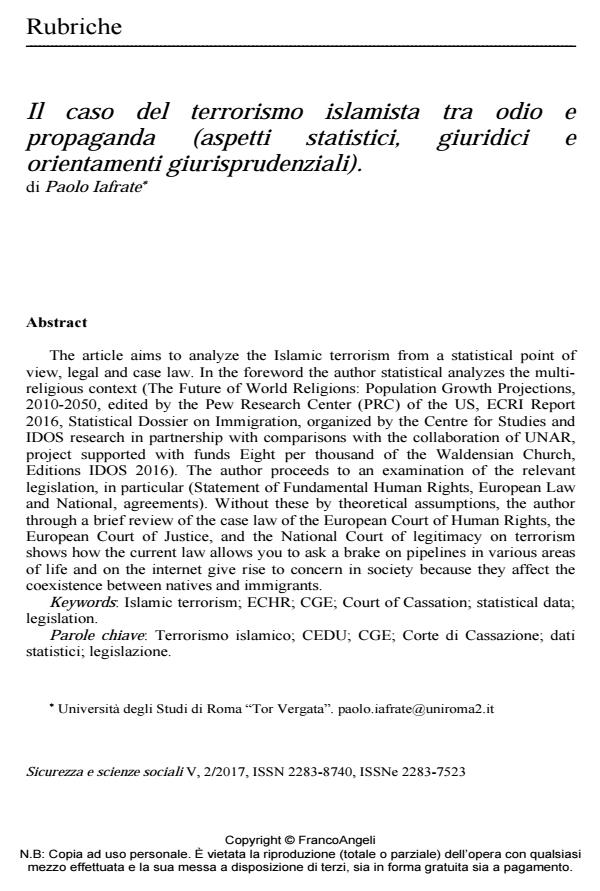Il caso del terrorismo islamista tra odio e propaganda (aspetti statistici, giuridici e orientamenti giurisprudenziali)
Titolo Rivista SICUREZZA E SCIENZE SOCIALI
Autori/Curatori Paolo Iafrate
Anno di pubblicazione 2017 Fascicolo 2017/2
Lingua Italiano Numero pagine 15 P. 179-193 Dimensione file 205 KB
DOI 10.3280/SISS2017-002011
Il DOI è il codice a barre della proprietà intellettuale: per saperne di più
clicca qui
Qui sotto puoi vedere in anteprima la prima pagina di questo articolo.
Se questo articolo ti interessa, lo puoi acquistare (e scaricare in formato pdf) seguendo le facili indicazioni per acquistare il download credit. Acquista Download Credits per scaricare questo Articolo in formato PDF

FrancoAngeli è membro della Publishers International Linking Association, Inc (PILA)associazione indipendente e non profit per facilitare (attraverso i servizi tecnologici implementati da CrossRef.org) l’accesso degli studiosi ai contenuti digitali nelle pubblicazioni professionali e scientifiche
The article aims to analyze the Islamic terrorism from a statistical point of view, legal and case law. In the foreword the author statistical analyzes the multi-religious context (The Future of World Religions: Population Growth Projections, 2010-2050, edited by the Pew Research Center (PRC) of the US, ECRI Report 2016, Statistical Dossier on Immigration, organized by the Centre for Studies and IDOS research in partnership with comparisons with the collaboration of UNAR, project supported with funds Eight per thousand of the Waldensian Church, Editions IDOS 2016). The author proceeds to an examination of the relevant legislation, in particular (Statement of Fundamental Human Rights, European Law and National, agreements). Without these by theoretical assumptions, the author through a brief review of the case law of the European Court of Human Rights, the European Court of Justice, and the National Court of legitimacy on terrorism shows how the current law allows you to ask a brake on pipelines in various areas of life and on the internet give rise to concern in society because they affect the coexistence between natives and immigrants.
Parole chiave:Terrorismo islamico; CEDU; CGE; Corte di Cassazione; dati statistici; legislazione.
Paolo Iafrate, Il caso del terrorismo islamista tra odio e propaganda (aspetti statistici, giuridici e orientamenti giurisprudenziali) in "SICUREZZA E SCIENZE SOCIALI" 2/2017, pp 179-193, DOI: 10.3280/SISS2017-002011